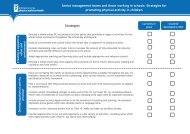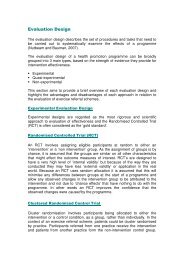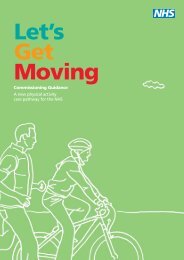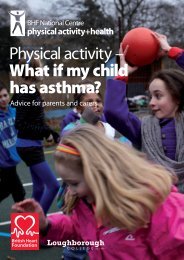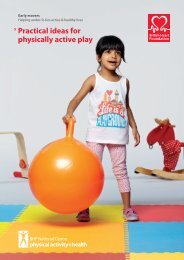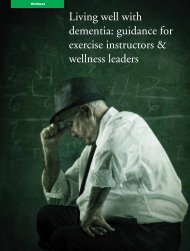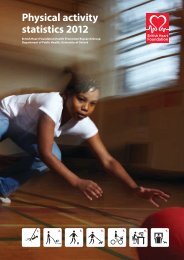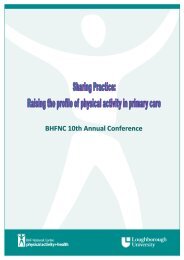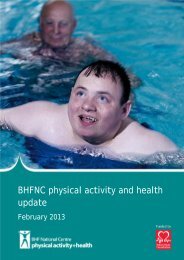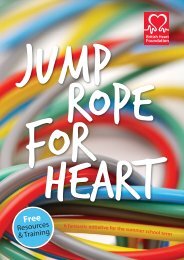Making the case for physical activity - BHF National Centre ...
Making the case for physical activity - BHF National Centre ...
Making the case for physical activity - BHF National Centre ...
Create successful ePaper yourself
Turn your PDF publications into a flip-book with our unique Google optimized e-Paper software.
Evidence Briefing1IntroductionPhysical in<strong>activity</strong> is known to be <strong>the</strong> fourth leadingcause of global mortality. Many of <strong>the</strong> leading causesof ill health in today’s society, such as coronaryheart disease, cancer and type 2 diabetes, couldbe prevented if more inactive people were tobecome active (1) . In <strong>the</strong> UK, <strong>the</strong> incidence ofnon-communicable disease which can be attributedto <strong>physical</strong> in<strong>activity</strong> includes:• 10.5% of coronary heart disease <strong>case</strong>s• 18.7% of colon cancer <strong>case</strong>s• 17.9% of breast cancer <strong>case</strong>s• 13.0% of type 2 diabetes <strong>case</strong>s• 16.9% of premature all-cause mortality (2) .In addition to reducing premature death and <strong>the</strong>incidence of disease, participating in <strong>physical</strong> <strong>activity</strong>also has benefits <strong>for</strong> mental health, quality of life andwellbeing and maintaining independent living in olderage. It can also play a key role in reducing health andsocial inequalities (3) . As a result of this wide-reachingimpact, <strong>physical</strong> <strong>activity</strong> has been described as <strong>the</strong>‘best buy in public health’ (4) .Key term – Physical <strong>activity</strong>Physical <strong>activity</strong> is described as any bodymovement produced by <strong>the</strong> skeletal muscles thatresults in a substantial increase over restingenergy expenditure (9) . Examples of <strong>physical</strong><strong>activity</strong> include play, lifestyle activities such aswalking and cycling (active transport), sportand recreational activities, household choresand gardening.Key term – Physical in<strong>activity</strong>Physical in<strong>activity</strong> is described as doing no orvery little <strong>physical</strong> <strong>activity</strong> at work, at home,<strong>for</strong> transport or during discretionary time andnot reaching <strong>physical</strong> <strong>activity</strong> guidelines deemednecessary to benefit public health (10) .Physical in<strong>activity</strong> also has a significant burden onhealthcare costs and <strong>the</strong> economy. In 2006/2007,£900 million was spent in <strong>the</strong> UK on ill health relatedto <strong>physical</strong> in<strong>activity</strong> (5) . The cost owing to <strong>physical</strong>in<strong>activity</strong> <strong>for</strong> different diseases was:• £117 million (stroke)• £542 million (heart disease)• £65 million (colorectal cancer)• £54 million (breast cancer)• £158 million (type 2 diabetes) (5) .<strong>Making</strong> <strong>physical</strong> <strong>activity</strong> a priority
4<strong>Making</strong> <strong>the</strong> <strong>case</strong> <strong>for</strong> <strong>physical</strong> <strong>activity</strong>Type 2 diabetes• Physical in<strong>activity</strong> is estimated to be <strong>the</strong> maincause of 27% of recorded <strong>case</strong>s of type 2 diabetesworldwide (1) .• 7% of <strong>the</strong> worldwide burden of type 2 diabetes couldbe eliminated if all inactive people became active (2) .• In <strong>the</strong> UK, if all inactive people were to becomeactive, 13% of type 2 diabetes <strong>case</strong>s couldpotentially be prevented (2) .• In adults already diagnosed with type 2 diabetes,<strong>physical</strong> <strong>activity</strong> can help maintain glycaemiccontrol which may reduce <strong>the</strong> risk of diabetescomplications (15) .Obesity• Beginning at a young age, <strong>physical</strong> <strong>activity</strong> is anessential component <strong>for</strong> energy balance andweight control (16) .• In children aged 0-5 years, lower levels of <strong>physical</strong><strong>activity</strong> are associated with increased levels ofobesity (17) .• Evidence suggests overweight or obese children tendto be less active, have less developed fundamentalmovement skills, have lower health-related fitnessand have an increased risk of cardiovascular andmetabolic diseases, eg, diabetes, than <strong>the</strong>ir normalweight counter parts (18) . However, it is difficult todetermine a cause and effect relationship betweenobesity and <strong>physical</strong> <strong>activity</strong> in children.• Men and women who are more <strong>physical</strong>ly activetend to have lower BMIs and smaller waistcircumferences (19, 20) .• Severely obese individuals (35+ body mass index -BMI) who do no leisure time <strong>physical</strong> <strong>activity</strong> maylose 7.2 years of life compared to a normal weightindividual (18.5 to 24.9 BMI) who meet <strong>the</strong> <strong>physical</strong><strong>activity</strong> recommendations (21) .
Evidence Briefing5Cancer prevention and management• Physical in<strong>activity</strong> is estimated to be <strong>the</strong> main causeof 21-25% of <strong>case</strong>s of breast and colon cancer (22) .• 10% of <strong>the</strong> worldwide burden of both breast andcolon cancers could be eliminated if all inactivepeople became active (2) .• In <strong>the</strong> UK, if all inactive people were to becomeactive, 18.7% of all colon cancer <strong>case</strong>s and 17.9%of all breast cancer <strong>case</strong>s could potentially beprevented (2) .• Those who are <strong>physical</strong>ly active have a lower riskof developing certain types of cancer than <strong>the</strong>irinactive counterparts:(11, 23)• 20-30% lower risk of developing colon cancer• 27% lower risk of developing endometrialcancer (24)• 20-40% lower risk of developing breast cancer (11) .• Evidence suggests cancer survivors who participate inregular <strong>physical</strong> <strong>activity</strong> can help reduce <strong>the</strong>ir risk ofcancer specific mortality and reoccurrence by:• 50% in those surviving colorectal cancer• 30% in those surviving prostate cancer• 40% in those surviving breast cancer (25) .• Individuals with higher levels of <strong>physical</strong> <strong>activity</strong>have a 30% risk reduction <strong>for</strong> developing lung cancerthan those with lower levels of <strong>physical</strong> <strong>activity</strong>.Similarly those with moderate levels of <strong>physical</strong><strong>activity</strong> have a 21% risk reduction compared tothose with lower <strong>physical</strong> <strong>activity</strong> levels (26) .• Emerging evidence suggests being <strong>physical</strong>ly activethroughout cancer treatment and during remissionhas positive effects on health and wellbeingincluding:• improvements in <strong>physical</strong> function• lower feelings of fatigue• improvements in quality of life scores• reduction in body fat• preservation of bone mineral density (25) .Liver disease• Emerging evidence suggests <strong>physical</strong> <strong>activity</strong> andexercise can play a valuable part in reducingliver fat and in managing patients with fatty liverdisorder (27, 28) .• There is modest evidence that <strong>the</strong> effects of<strong>physical</strong> <strong>activity</strong> on liver fat are independent ofweight loss (27, 28) .Osteoporosis• Habitually inactive individuals are 1.59 timesmore likely than active individuals to developosteoporosis (11) .• Weight bearing activities in <strong>the</strong> early stages ofpuberty allow <strong>for</strong> peak bone mineral densityaccrual which may help protect against fractures inlater life (29) .<strong>Making</strong> <strong>physical</strong> <strong>activity</strong> a priority
6<strong>Making</strong> <strong>the</strong> <strong>case</strong> <strong>for</strong> <strong>physical</strong> <strong>activity</strong>• In pre-menopausal women, high impact exercise,such as hopping, has <strong>the</strong> potential to bring about a3.6% to 6.4% decrease in <strong>the</strong> risk of hip fracture (30) .• There is evidence that post-menopausal women whoare active are likely to have 0.85% to 3.2% less spinalbone loss and 1.03% bone loss at <strong>the</strong> hip than thosewho are inactive (31) .Reducing risk of premature all-cause mortality• In <strong>the</strong> UK, if all inactive people were to becomeactive, 16.9% of premature deaths from all causescould potentially be prevented (2) .• If <strong>physical</strong> in<strong>activity</strong> were to be eliminated from<strong>the</strong> UK population, <strong>the</strong> median life expectancywould increase by 1.07 years (ranging from 0.85 to1.29 years) (2) .• Regardless of BMI or weight, <strong>activity</strong> levels have <strong>the</strong>potential to impact on life expectancy. For example:• Individuals classified as active but overweight(25 to 29.9 BMI) have <strong>the</strong> same life expectancyas active and normal weight individuals.• Normal weight but inactive individuals mayhave 3.1 fewer years of life compared to obese(30 to 34.9 BMI) but active individuals (21) .
Evidence Briefing7Enhancing mental health,quality of life and self-reportedwellbeingHealth-related quality of life refers specifically to anindividual’s perception of <strong>the</strong>ir health and wellbeing.It incorporates measures of an individual’s <strong>physical</strong>,mental, functional, social and emotional status.Physical <strong>activity</strong> can play an important role in helpingto enhance multiple indicators within this quality oflife measure.Children and adolescents• Participation in <strong>physical</strong> <strong>activity</strong> has been shown tobe effective <strong>for</strong> reducing:• depression• anxiety• psychological distress• emotional disturbance (19) .• Physical <strong>activity</strong> participation can significantlyenhance self-esteem (32) and self-concept (33) .Adults• On average, active adults have a 30% lower chanceof feeling distressed or a 30% higher chance ofenhanced wellbeing than inactive adults (19) .• Physically active adults have a 20-30% lower risk ofdepression, distress and dementia (19) .• There is some evidence that <strong>physical</strong> <strong>activity</strong>improves sleep (19) .Older adults• Being <strong>physical</strong>ly active in later life can help enhancequality of life by improving:• mental wellbeing• cognitive and emotional functioning• psychological wellbeing• satisfaction with life (and decreasing loneliness)• mood• <strong>physical</strong> functioning (34) .• Levels of <strong>physical</strong> <strong>activity</strong> are inversely associated withlevels of depression in both healthy older adults andthose already diagnosed with clinical depression (34) .• Physically fit older adults have better cognitivefunctioning than those who are unfit (34) .• In older adults without dementia, exercisesignificantly improves memory, attention andprocessing speed (35) .• Older adults who participate in high levels of <strong>physical</strong><strong>activity</strong> have a 38% reduced risk of cognitive declineand those with low-to-moderate levels of <strong>physical</strong><strong>activity</strong> have a 35% reduced risk of cognitive declinecompared to sedentary individuals (36) .Special populations• In those with osteoarthritis, <strong>physical</strong> <strong>activity</strong> canprovide significant improvements in pain, <strong>physical</strong>function and mental health (19) .• In cancer survivors <strong>physical</strong> <strong>activity</strong>, particularlywalking, is linked with improved quality of life bothduring and after treatment (19) .• In those with mental health conditions, <strong>physical</strong><strong>activity</strong> may not only reduce <strong>the</strong> onset or progressionof <strong>the</strong>se conditions but may also reduce <strong>the</strong> negativeimpact of <strong>the</strong>se conditions on quality of life, selfesteemand feelings of fatigue (19) .<strong>Making</strong> <strong>physical</strong> <strong>activity</strong> a priority
8<strong>Making</strong> <strong>the</strong> <strong>case</strong> <strong>for</strong> <strong>physical</strong> <strong>activity</strong>Delaying <strong>the</strong> need <strong>for</strong> care inolder adults (age 65+)Worldwide, <strong>the</strong> number of adults in <strong>the</strong> populationaged 65 and older is growing rapidly. In <strong>the</strong> UK, <strong>the</strong>fastest growing age group in <strong>the</strong> entire population isthose aged 85 years and over, ie, <strong>the</strong> ‘oldest old’. Withcontinual growth over <strong>the</strong> last 25 years, this populationgroup reached 1.3 million in 2007, meaning that todaythose aged 85 and over represents 2.1% of <strong>the</strong> totalpopulation of <strong>the</strong> UK (37) . Due to <strong>the</strong> rising cost of careand <strong>the</strong> impact <strong>the</strong> loss of autonomy can have onmental wellbeing, it is important to ensure older adultsstay independent <strong>for</strong> as long as possible.Reducing falls and falls related injuries• By being <strong>physical</strong>ly active on a regular basis, olderadults have a 30-50% lower risk of developingfunctional limitations (19, 38) .• There is a dose-response relationship between<strong>physical</strong> <strong>activity</strong> and hip fracture risk, meaning <strong>the</strong>more <strong>physical</strong> <strong>activity</strong> people do <strong>the</strong> less <strong>the</strong>ir riskof suffering a hip fracture. Individuals doing <strong>the</strong>greatest amounts of moderate <strong>physical</strong> <strong>activity</strong>may experience a 36-68% reduction in <strong>the</strong> risk of ahip fracture (19) .Supporting independent living• Decline in functional status is a contributing factorto admissions to residential and nursing carehomes (39) .• Risk factors <strong>for</strong> decline in functional status include:• depression• cognitive impairment• functional limitations, eg, falls, reducedextremity per<strong>for</strong>mance• low levels of social <strong>activity</strong>• social contact (39) .• Physical <strong>activity</strong> can reduce <strong>the</strong> decline infunctional status by enabling older adults tocontinue per<strong>for</strong>ming tasks of daily living, delaying<strong>the</strong> decline in cognitive function and providing amedium <strong>for</strong> social interaction (34) .Dementia• Physical <strong>activity</strong> can help delay <strong>the</strong> onset ofcognitive decline experienced with old age anddelay <strong>the</strong> development of dementia (19) .• In individuals who have already experienced mentaldecline, <strong>physical</strong> <strong>activity</strong> can help improve aspectsof cognitive function and reduce symptoms ofdementia (19) .• Exercise has demonstrated significant cognitivebenefits even in those with mild cognitiveimpairment or dementia (35) .• There is currently insufficient evidence on <strong>the</strong>benefits of <strong>physical</strong> <strong>activity</strong> on quality of life anddepression in older adults with dementia (40) .• Physical <strong>activity</strong> has been found to have a positiveeffect on basic activities of daily living and <strong>physical</strong>functioning in older adults with all stages ofdementia (41) .
Evidence Briefing9Reducing health inequalitiesand improving wider factors ofhealth and wellbeingThe Marmot Review (2010) highlighted curren<strong>the</strong>alth and social inequalities across England andrecommended policy objectives, such as healthystandard of living, fair work <strong>for</strong> all and giving children<strong>the</strong> best start in life, to help reduce inequalitiesacross <strong>the</strong> life course (42) . The role <strong>physical</strong> <strong>activity</strong> canplay in reducing some of <strong>the</strong>se health inequalities issummarised below.Social inequalitiesThere is known to be a social gradient associatedwith healthy lifestyles, including levels of <strong>physical</strong><strong>activity</strong>, with those in higher socio-economicgroups experiencing healthier and longer lives thanthose in more deprived areas. If health inequalitieswere reduced:• 285 million years of healthy life could be gainedif everyone experienced <strong>the</strong> same rates of illness,disability and death seen in <strong>the</strong> 10% of <strong>the</strong> leastdeprived areas (42) .• 2.3 million years of life could be saved and 67,000fewer deaths experienced in <strong>the</strong> working agegroup (age 30 to 59) if <strong>the</strong> mortality rates fromo<strong>the</strong>r classes were <strong>the</strong> same as that of <strong>the</strong> ‘highermanagerial and professional’ class (42) .Giving children <strong>the</strong> best start in life andmaximising <strong>the</strong>ir potential• During infancy, <strong>physical</strong> <strong>activity</strong> can have apositive impact on motor skills and cognitivedevelopment (43) .• In pre-schoolers, <strong>physical</strong> <strong>activity</strong> is associatedwith improved measures of psychosocial health andmotor skills development (43) .• While <strong>the</strong>re is limited evidence about how well<strong>physical</strong> <strong>activity</strong> levels during childhood relatesto <strong>physical</strong> <strong>activity</strong> levels during adulthood, itis still important to promote healthy behavioursthroughout <strong>the</strong> early years, childhood andadolescences (44, 45) .<strong>Making</strong> <strong>physical</strong> <strong>activity</strong> a priority
Evidence Briefing11References1. World Health Organization. Global recommendations on<strong>physical</strong> <strong>activity</strong> <strong>for</strong> health. Geneva, Switzerland: WHOPress; 2010.2. Lee I, Shiroma EJ, Lobelo F, Puska P, Blair SN,Katzmarzyk PT, <strong>for</strong> <strong>the</strong> Lancet Physical Activity SeriesWorking Group. Effect of <strong>physical</strong> in<strong>activity</strong> on majornon-communicable diseases worldwide: An analysisof burden of disease and life expectancy. The Lancet.2012;380(9838):219-229.3. Marmont M. Social determinants of health inequalities.The Lancet. 2005;365(9464):1099-1104.4. Morris JN. Exercise in <strong>the</strong> prevention of coronary heartdisease: Today’s best buy in public health. Med SciSports Exerc. 1994;26(7):807-14.5. Scarborough P, Bhatnagar P, Wickramasinghe KK, AllenderS, Foster C, Rayner M. The economic burden of ill healthdue to diet, <strong>physical</strong> in<strong>activity</strong>, smoking, alcohol andobesity in <strong>the</strong> UK: An update to 2006-2007 NHS costs.Journal of Public Health. 2011;33(4):527-535.6. Black C. Working <strong>for</strong> a healthier tomorrow - Dame CarolBlack’s review of <strong>the</strong> health of Britain’s working agepopulation. London, England: Crown Copyright; 2008.7. The Department of Health. Start active, stay active:A report on <strong>physical</strong> <strong>activity</strong> <strong>for</strong> health from <strong>the</strong>four home countries’ chief medical officers. London,England: The Department of Health; 2011.8. Townsend N, Bhatnagar P, Wickramasinghe K, ScarboroughP, Foster C, Rayner M. Physical <strong>activity</strong> statistics 2012.London, England: British Heart Foundation and Ox<strong>for</strong>d,England: University of Ox<strong>for</strong>d; 2012.9. Bouchard C, Shephard RJ. Physical <strong>activity</strong>, fitness,and health: The model and key concepts. In: BouchardC, Shephard RJ, Stephens T, editors. Physical <strong>activity</strong>,fitness and health: International proceedings andconsensus statement. Champaign, Ill: Human Kinetics;1994. p. 77-88.10. Bull FC, Armstrong TP, Dixon T, Ham S, Neiman A, PrattM. Chapter 10 Physical in<strong>activity</strong>. In: Ezzati M, LopezAD, Rodgers A, Murray CJL, editors. Comparativequantification of health risks: Global and regional burdenof disease attributable to selected major risk factors.Volume 1. Switzerland: WHO Press; 2004. p. 729-881.11. Warburton DE, Charlesworth S, Ivey A, Nettlefold L,Bredin SS. A systematic review of <strong>the</strong> evidence <strong>for</strong>Canada’s <strong>physical</strong> <strong>activity</strong> guidelines <strong>for</strong> adults. Int JBehav Nutr Phys Act. 2010;7(39).12. Li J, Siegrist J. Physical <strong>activity</strong> and risk of cardiovasculardisease - a meta-analysis of prospective cohort studies.Int J Environ Res Health. 2012;9(2):391-407.13. Sattelmair J, Pertman J, Ding EL, Kohl HWI, HaskellW, Lee IM. Dose response between <strong>physical</strong> <strong>activity</strong>and risk of coronary heart disease: A meta-analysis.Circulation. 2011;124:789-95.14. Fagart RH. Exercise is good <strong>for</strong> your blood pressure:Effects of endurance training and resistance training.Clin Exp Pharmacol Physiol. 2006;33(9):853-6.15. Miller YD, Dunstan DW. The effectiveness of <strong>physical</strong><strong>activity</strong> interventions <strong>for</strong> <strong>the</strong> treatment of overweightand obesity and type 2 diabetes. J Sci Med Sport.2004;7(1):Supplement:52-59.16. Chaput J, Klingenberg L, Rosenkilde M, Gilbert J,Tremblay A, Sjodin A. Physical <strong>activity</strong> plays animportant role in body weight regulation. J Obes.2011;2011(360257).17. Monasta L, Batty GD, Cattaneo A, Lutje V, RonfaniL, van Len<strong>the</strong> FJ, et al. Early-life determinants ofoverweight and obesity: A review of systematic reviews.Obes Rev. 2010;11(10):695-708.18. Hills AP, Andersen LB, Byrne NM. Physical <strong>activity</strong> andobesity in children. Br J Sports Med. 2011;45(11):866-870.19. Physical Activity Guidelines Advisory Committee.Physical <strong>activity</strong> guidelines advisory committee report,2008. Washington, DC: U.S. Department of Health andHuman Services; 2008.20. Besson H, Ekelund U, Luan J, May AM, Sharp S, Travier N,et al. A cross-sectional analysis of <strong>physical</strong> <strong>activity</strong> andobesity indicators in European participants of <strong>the</strong> EPIC-PANACEA study. Int J Obes (Lond). 2009;33(4):497-506.21. Moore SC, Patel AV, Mat<strong>the</strong>ws CE, Berrington deGonzalez A, Park Y, Katki HA, et al. Leisure time<strong>physical</strong> <strong>activity</strong> of moderate to vigorous intensity andmortality: A large pooled cohort analysis. PLos Med.2012;9(11):e1001335.<strong>Making</strong> <strong>physical</strong> <strong>activity</strong> a priority



